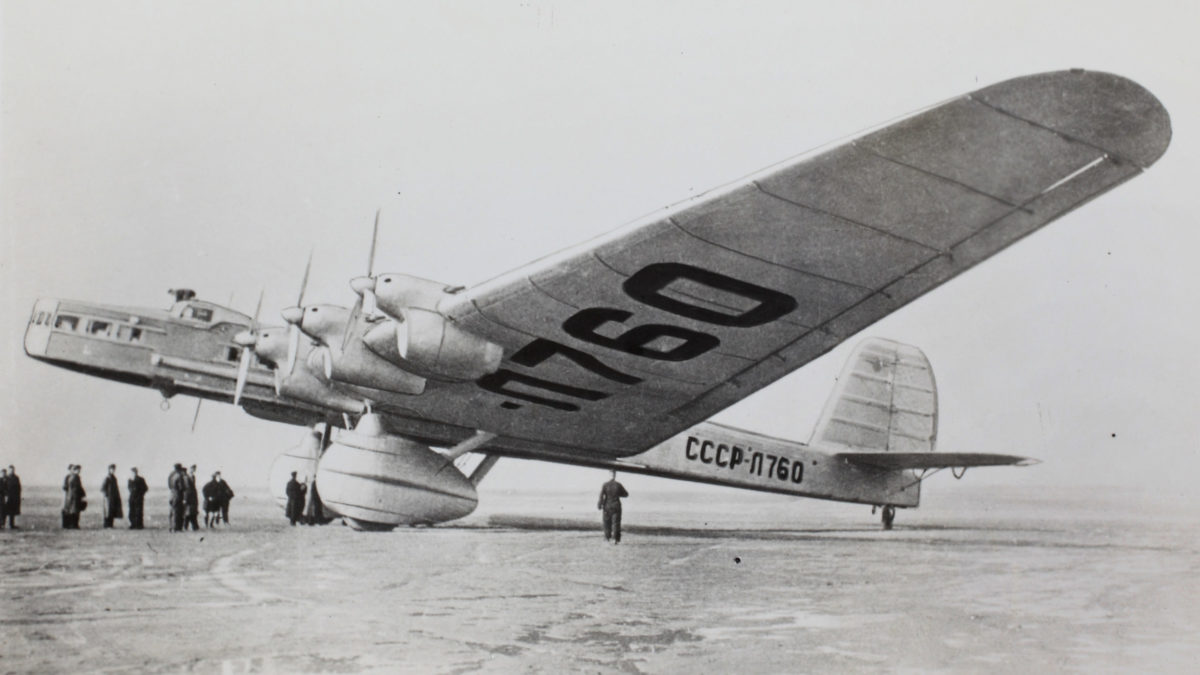Russian designer Igor Sikorsky was first to develop a giant, four-engine airplane with his Bolshoi Baltitsky in 1913 and ever since then the Russian aircraft industry has seen the regular emergence of designers who compulsively think big. The 1930s, a time when the Soviet Union’s industrial power was growing and dictator Josef Stalin was keen to show its achievements off to the rest of the world, was one such fertile environment for a crop of flying giants. Among those who took up the challenge with enthusiasm was Andrei Tupolev, whose efforts led to the ANT-20 and its improved successor, the ANT-20bis (shown here)—the largest airplanes of their time.
It was the words of journalist Mikhail Koltsov that inspired Tupolev’s colossi. “The construction of a giant propaganda plane will revitalize our agitprop methods as the country reaches new technological heights,” he wrote in 1932. Stalin agreed and on May 13, 1934, the Tupolev design took to the air. Powered by six 900-hp Mikulin AM-34FRN 12-cylinder liquid-cooled engines driving two-bladed variable-pitch propellers, the ANT-20 had a wingspan of 206 feet 8 inches, a wing area of 5,250 square feet and was 107 feet, 11 inches long. Empty weight was 62,832 pounds and gross weight 92,594 pounds. When it became evident that the airplane lacked the power to get airborne, Tupolev mounted two more engines in tandem above the fuselage. Helping to control all that horsepower and weight was one of the first autopilots to be installed in a Soviet airplane. Maximum speed was 140 mph, range was 750 miles and ceiling 14,800 feet.
Tupolev emulated Professor Hugo Junkers’ use of corrugated metal to skin the airframe, making the ANT-20 the largest aircraft in history to employ that material. It carried an eight-man crew and up to 48 passengers.
Christened Maxim Gorky after the renowned writer, the ANT-20 literally produced its own propaganda. Its normal payload included an auxiliary motor that could generate enough electricity to power communication equipment, a loudspeaker, a photographic darkroom and a printing press that could churn out 10,000 leaflets an hour.
After several successful flights, Maxim Gorky was overflying Moscow on May 18, 1935, accompanied by a Tupolev ANT-14 transport, a Polikarpov R-5 bomber and a Polikarpov I-5 fighter to provide spectators with a sense of scale. As they overflew the capital, Lieutenant Nikolai Blagin broke formation and put his I-5 through two loops around the ANT-20’s wing. On the third loop, however, he collided with Maxim Gorky, resulting in both planes crashing near what is now the Sokol metro station. Blagin, the ANT-20’s pilots, 33 passengers and nine people on the ground were killed. Whether or not Blagin had acted under orders or on his own initiative, his name was blackened as a synonym for selfish glory-seeking at the expense of others: blaginism.
Within the next year Tupolev’s design bureau was working on a second giant using six 1,200-hp AM-34FRNV wing-mounted engines whose collective power permitted the deletion of the tandem-engine fuselage pod. Slightly larger than its predecessor, the ANT-20bis (“modified” or “improved”) had a wingspan of 208 feet 8 inches, a wing area of 5,228 square feet and was 111 feet, 10 inches long. Empty weight was 62,700 pounds and gross weight 92,600 pounds. The airplane’s maximum speed was 170 mph, range was 620 miles and ceiling 24,600 feet. It could accommodate up to 64 passengers and consideration was given to carrying paratroopers or bombs, although neither configuration was followed up.
Making its first flight on May 15, 1939, the second giant saw considerably more use than its predecessor, transporting passengers and cargo throughout Central Asia. While flying from Chardzhu to Tashkent, Turkmenistan, on December 14, 1942, however, a pilot let a passenger take momentary control of the aircraft, and as he returned to his seat the departing passenger accidentally disengaged the autopilot. This caused a sudden nosedive from 1,600 feet and the ANT-20bis crashed to earth at an 80-degree angle, killing all 36 people aboard.
By then even the journalist whose words inspired the ANT-20’s creation had fallen victim to his own ill fortune. After having a falling-out with Stalin, on February 2, 1940, Mikhail Koltsov was arrested on a charge of “participation in a conspiracy against the Communist Party and Soviet power” and summarily shot.

